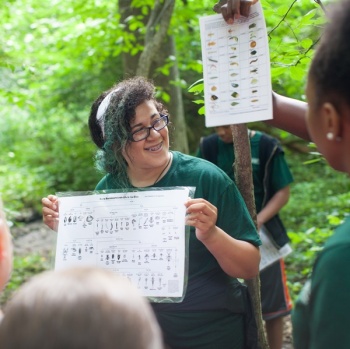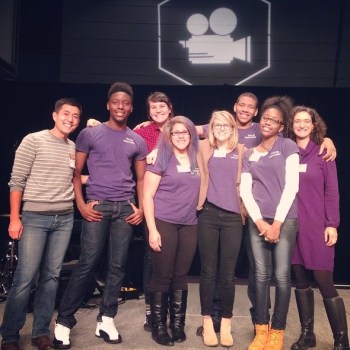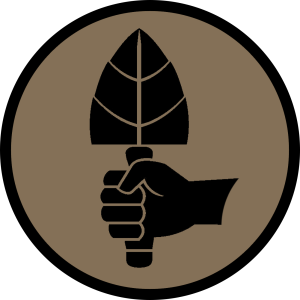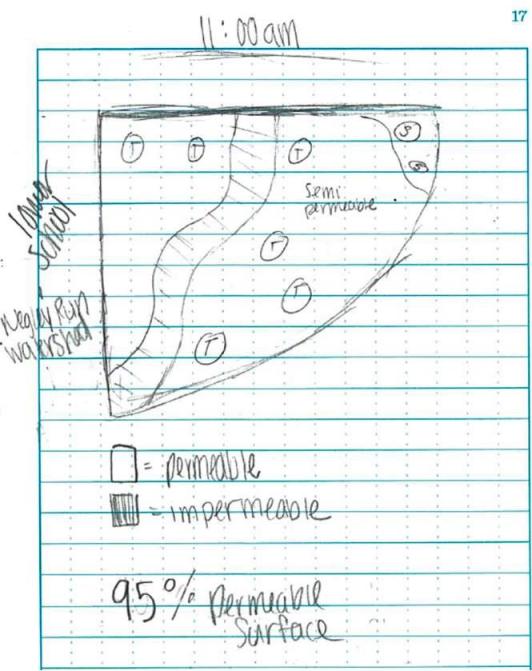What does it mean to be a life-wide learner? How does one travel a learning pathway?
Educators talk about moments when students “light up,” or demonstrate curiosity and an interest in learning more. Last year, I had the opportunity to spark those light-up moments while working with Pittsburgh Parks Conservancy educators as an Activation Lab Design Fellow, a position with the Activation Lab, funded by the The Grable Foundation.
My goal? Design life-wide learning environments (learning that takes place both in and out of school) that ignite interest in students and encourage persistent engagement.

Young Naturalists teaching youth how to identify macroinvertebrates.
To do this, I worked with Parks Conservancy educators on designing learning pathways that would lead students from the High School Urban EcoStewards program (a program through their schools) into the Young Naturalists program (an independent summer opportunity).
Teachers were critical partners along the pathway. They identified students who would be a good fit for the Young Naturalist program and supported them through the application process. With teachers as “learning brokers,” programs successfully drew youth from multiple high schools and neighborhoods. Strategic social support encouraged students to explore opportunities offered by other organizations. In fact, this summer, two of the Young Naturalists will be involved in field study and conservation work in our national parks as Student Conservation Association crew members.
Informal learning programs encourage rich learning experiences that build on what happens in the classroom. Programs like these in the parks are more flexible in honoring joy, humor, compassion, spirit, risk-taking, innovation, and curiosity as essential elements of knowing, learning and relating. They allow learners those chances to “light up,” cultivate a deeper sense of interconnectedness, and create their own personalized learning pathways that break out of the often-rigid structure of schools.
We didn’t test the Young Naturalists to see if the program improved academic performance; rather, we observed them engage with the natural world around them with increasing confidence, ask questions to further their understanding, and listened to them as they described how they carried their learning into their everyday lives.

The five Young Naturalists presented to hundreds at the Sprout Learning Pathways Summit at the end of their program.
Every run I have on Falls Ravine trail in Frick Park triggers a memory of the Young Naturalists guiding young summer camp participants in finding and identifying macroinvertebrates in the creek.
Every day I think about a conversation with one of the participants in which she explained how she now catches herself instinctively identifying trees on her walks to school.
These memories are evidence of how informal learning programs can enrich and empower our young people, and I draw from them often to inform my own research, which I hope will contribute to the design of practices and infrastructures that expand equitable access to rich learning contexts.
Imagine if learning pathways like these were available for every learner in our region for whatever topic they were interested in? The Parks Conservancy was successful in bringing together a diverse set of learners through social support on a pathway that spanned the divide between in-school and out-of-school learning. Organizational practices like this have the potential to transform our regional learning landscapes from a set of individual programs to truly interconnected learning contexts that support the learning and development of all youth.
Stacy Kehoe is a doctoral student in Learning Sciences and Policy at the University of Pittsburgh. Previously, she developed enrichment models for a public high school in Brooklyn, linking students to programs for travelling abroad, pre-college, visual and performing arts, the environment, and youth leadership. She is pursuing her graduate degree to study the incredible results she saw in Brooklyn and replicate them here in Pittsburgh.



 For up-and-coming environmentalists with diverse interests, a new opportunity to build and share skill sets is about to go viral.
For up-and-coming environmentalists with diverse interests, a new opportunity to build and share skill sets is about to go viral.  Beginner tree ID badge
Beginner tree ID badge Birding basics badge
Birding basics badge Healthy parks, healthy cities badge
Healthy parks, healthy cities badge Urban EcoSteward badge
Urban EcoSteward badge Young Naturalist badge
Young Naturalist badge






